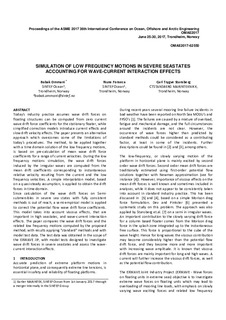| dc.contributor.author | Ommani, Babak | |
| dc.contributor.author | Fonseca, Nuno | |
| dc.contributor.author | Stansberg, Carl Trygve | |
| dc.date.accessioned | 2017-10-12T06:41:52Z | |
| dc.date.available | 2017-10-12T06:41:52Z | |
| dc.date.created | 2017-10-11T10:02:51Z | |
| dc.date.issued | 2017-06-25 | |
| dc.identifier.citation | ASME 2017 36th International Conference on Ocean, Offshore and Arctic Engineering - Volume 1: Offshore Technology | nb_NO |
| dc.identifier.isbn | 978-0-7918-5763-2 | |
| dc.identifier.uri | http://hdl.handle.net/11250/2459784 | |
| dc.description.abstract | Today’s industry practice assumes wave drift forces on floating structures can be computed from zero current wave drift force coefficients for the stationary floater, while simplified correction models introduce current effects and slow drift velocity effects. The paper presents an alternative approach which overcomes some of the limitations of today’s procedures. The method, to be applied together with a time domain solution of the low frequency motions, is based on pre-calculation of mean wave drift force coefficients for a range of current velocities. During the low frequency motions simulation, the wave drift forces induced by the irregular waves are computed from the mean drift coefficients corresponding to instantaneous relative velocity resulting from the current and the low frequency velocities. A simple interpolation model, based on a quasi-steady assumption, is applied to obtain the drift forces in time-domain. Since calculation of the wave drift forces on Semi-submersibles in severe sea states with fully consistent methods is out of reach, a semi-empirical model is applied to correct the potential flow wave drift force coefficients. This model takes into account viscous effects, that are important in high seastates, and wave-current interaction effects. The paper compares the wave drift forces and the related low frequency motions computed by the proposed method, with results applying “standard” methods and with model test data. The test data was obtained in the scope of the EXWAVE JIP, with model tests designed to investigate wave drift forces in severe seastates and assess the wave-current interaction effects. | nb_NO |
| dc.language.iso | eng | nb_NO |
| dc.relation.ispartof | ASME 2017 36th International Conference on Ocean, Offshore and Arctic Engineering - Volume 1: Offshore Technology | |
| dc.relation.ispartofseries | ASME Proceedings | Offshore Technology;OMAE2017-62550 | |
| dc.subject | Simulation | nb_NO |
| dc.subject | Waves | nb_NO |
| dc.subject | Accounting | nb_NO |
| dc.title | Simulation of Low Frequency Motions in Severe Seastates Accounting for Wave-Current Interaction Effects | nb_NO |
| dc.type | Chapter | nb_NO |
| dc.description.version | acceptedVersion | nb_NO |
| dc.rights.holder | Copyright © 2017 by ASME | nb_NO |
| dc.identifier.doi | 10.1115/OMAE2017-62550 | |
| dc.identifier.cristin | 1503737 | |
| cristin.unitcode | 7566,8,0,0 | |
| cristin.unitcode | 7566,9,0,0 | |
| cristin.unitname | Ocean Engineering | |
| cristin.unitname | Hydrodynamikk | |
| cristin.ispublished | true | |
| cristin.fulltext | postprint | |
| cristin.qualitycode | 1 | |
